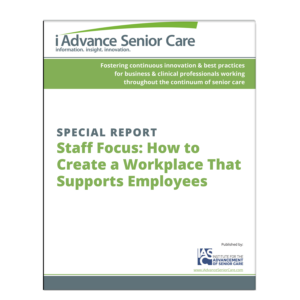Will immigration reform solve staffing woes?
Research repeatedly confirms that the quality of long-term care depends on staffing levels. Technology and evidence-based practices can make important contributions, but the ability to provide assistance and services to people who have significant limitations and health problems ultimately rests on having enough staff to respond to their needs.
For this reason, the long-term care industry has been very attentive to policy changes and proposals affecting the availability of personnel. Some of these changes involve reimbursement levels that constrain the ability of nursing homes to hire staff in a tight labor market. In 2007, however, the major focus of Capitol Hill is on those sources overseas of people who could eventually work in long-term care.
During the past 10 years, legal immigration to the United States has become increasingly difficult. The simple truth is that people who legally wish to live and work in the United States and become permanent residents must often wait five or more years to obtain a visa. Meanwhile, nonrefundable fees for applying for a U.S. visa have skyrocketed as federal agencies try to milk these “user costs” for a substantial portion of their operating budgets. Thus, a would-be immigrant from a former Soviet bloc country in Eastern Europe with a college education but no job experience may expect to pay several months’ salary simply to apply for a visa—and then face several years of uncertainty over whether the application will be granted.
A combination of other factors also reduces the healthcare field's ability to tap into long-established sources of immigrant workers. Improved economies in Western Europe and Australia, the declining value of the dollar, and new rules in Europe relaxing old barriers to cross-border employment mean that the likelihood of recruiting recently arrived, English-speaking staff from Europe and Canada is diminishing. In fact, the past few years have witnessed a growing trend among immigrants from Russia, Ireland, India, and other countries choosing to emigrate from the United States to take advantage of employment opportunities “back home.”
This situation has motivated lobbyists for the nursing home industry to become fairly reliable advocates for policies that will increase the availability of workers from Asia, Central America, Mexico, and the Pacific Islands. American Health Care Association in particular has expressed frustration over the slow pace of the immigration reform that President George W. Bush had described in 2001 as a top priority of his administration. That priority was derailed by post-9/11 issues of national security and by outrage among members of his own party over the millions of Mexicans, Central Americans, and Asians who have illegally arrived and settled in the United States.
Election of a Democratic majority to Congress in 2006 effectively liberated the President from the need to rely solely on support from his own party members for passage of an immigration reform package. Accordingly, this spring, the White House successfully negotiated with a bipartisan coalition, including onetime Bush rival Sen. John McCain (R-Ariz.) and liberal icon Sen. Edward Kennedy (D-Mass.), a complex compromise that might greatly increase the availability of low-wage workers.
At this writing, however, the proposed immigration reform legislation has generated two major questions: Can it help ease the staffing shortages in long-term care, and can it be passed by a narrowly divided Congress?
The first question is surprisingly difficult because long-term care actually faces two separate staffing problems. Nursing homes face a systemic shortage of nurses and other clinical staff; they cannot compete with the salaries offered by hospitals, outpatient practices, and managed care companies for the shrinking pool of trained clinical and clinical support personnel. Nursing homes depend heavily on low-skill, low-wage workers to provide affordable support services such as laundry, housekeeping, transportation, and food preparation. Some of these low-income personnel are employed directly by the long-term care industry, but many are outsourced from companies that supply nursing homes with necessary goods and services. Ideally, an immigration reform package would address both of these staffing problems by making it easier for nurses to cross borders to work in the United States, while ensuring a steady supply of dependable, motivated, low-wage support workers.
The compromise provided in S. 1348, the Senate's version of the comprehensive immigration reform legislation, attempts to cover both of these needs. One of the best-known proposals in the bill is the establishment of a temporary guest worker program, known as the H-2C visa, that would permit aliens and their spouses and children to work in the United States for a three-year period and then, after a one-year absence in their home country, allow them to receive an additional three-year extension. This controversial legislation, coupled with increased penalties for U.S. employers of illegal aliens, is designed to increase the pool of legal, low-income workers. A much less known provision of the legislation would eliminate the existing cap on importation of nurses and other foreign clinical personnel who earned a master's or higher degree from an accredited U.S. university or were awarded a medical specialty certification based on postdoctoral training and experience in the United States. A third, almost unknown aspect of the bill effectively could help facilitate immigration of nursing personnel from the Philippines by providing “special relief” for adult children of Filipino World War II veterans.
Critics charge that none of these provisions represents an ideal solution. Advocates for more open immigration complain that the guest worker visas are so restricted that they will not achieve their goal of reducing illegal immigration and will, at the same time, create a new class of workers without a permanent stake in their community. Advocates for increasing the availability of nurses and other clinical specialists point out that the proposed changes in visa status apply only to individuals who previously entered the United States under a student visa and disparage the quality of medical education available overseas.
And, of course, none of these changes will directly affect the real challenge of nursing home staffing: how to provide adequate personnel in the face of lower reimbursement rates and the anticipated rise in the federal minimum wage. In short, as in any legislative compromise, the provisions of S. 1348 can be seen either as tentative steps in the right direction or as seriously flawed policies.
The compromise nature of the legislation also explains why its passage could be in jeopardy as of this writing. Very simply, advocates for freer movement of workers across borders view the bill as too punitive and too restrictive. Advocates for more secure borders complain that some of the bill's provisions would allow illegal aliens to obtain legal residence and could increase their access to publicly supported health and human service programs.
Passage of the bill thus requires a large enough bipartisan group of legislators who are neither devoted to resurrecting the immigration policies of the past nor eager to scrap nearly all restrictions on immigration. This is the most reasonably hopeful position imaginable. If such a group doesn't coalesce before Election 2008 really heats up, the brief window of opportunity for doing anything substantive on immigration may slam shut.
To send your comments to the author and editors, e-mail stoil0607@nursinghomesmagazine.com.
Related Articles
Topics: Articles , Staffing











